Molecular Composition of Stream Dissolved Organic Matter in Cool-Temperate Forest Headwaters with Landslides, Northern Japan
Abstract
1. Introduction
2. Materials and Methods
2.1. Site Description
2.2. Hydrological Observations and Water Sampling
2.3. Chemical and Data Analyses
3. Results
4. Discussion
5. Conclusions
Author Contributions
Funding
Data Availability Statement
Acknowledgments
Conflicts of Interest
References
- Borga, M.; Stoffel, M.; Marchi, L.; Marra, F.; Jakob, M. Hydrogeomorphic Response to Extreme Rainfall in Headwater Systems: Flash Floods and Debris Flows. J. Hydrol. 2014, 518, 194–205. [Google Scholar] [CrossRef]
- Kato, A.; Ben-Zion, Y. The Generation of Large Earthquakes. Nat. Rev. Earth Environ. 2021, 2, 26–39. [Google Scholar] [CrossRef]
- Marc, O.; Hovius, N.; Meunier, P.; Uchida, T.; Hayashi, S. Transient Changes of Landslide Rates After Earthquakes. Geology 2015, 43, 883–886. [Google Scholar] [CrossRef]
- Nelson, E.J.; Kareiva, P.; Ruckelshaus, M.; Arkema, K.; Geller, G.; Girvetz, E.; Goodrich, D.; Matzek, V.; Pinsky, M.; Reid, W.; et al. Climate Change’s Impact on Key Ecosystem Services and the Human Well-being They Support in the US. Front. Ecol. Environ. 2013, 11, 483–893. [Google Scholar] [CrossRef]
- Wu, Z.; Fang, H. Snowmelt Erosion: A Review. Earth-Sci. Rev. 2024, 250, 104704. [Google Scholar] [CrossRef]
- Eisenbies, M.H.; Aust, W.M.; Burger, J.A.; Adams, M.B. Forest Operations, Extreme Flooding Events, and Considerations for Hydrologic Modeling in the Appalachians—A Review. For. Ecol. Manag. 2007, 242, 77–98. [Google Scholar] [CrossRef]
- Thom, D.; Seidl, R. Natural Disturbance Impacts on Ecosystem Services and Biodiversity in Temperate and Boreal Forests. Biol. Rev. 2016, 91, 760–781. [Google Scholar] [CrossRef]
- Seidl, R.; Spies, T.A.; Peterson, D.L.; Stephens, S.L.; Hicke, J.A. Searching for Resilience: Addressing the Impacts of Changing Disturbance Regimes on Forest Ecosystem Services. J. Appl. Ecol. 2016, 53, 120–129. [Google Scholar] [CrossRef]
- Koenings, J.P.; Hooper, F.F. The Influence of Colloidal Organic Matter on Iron and Iron-Phosphorus Cycling in an Acid Bog Lake1. Limnol. Oceanogr. 1976, 21, 684–696. [Google Scholar] [CrossRef]
- Francko, D.A. Epilimnetic Phosphorus Cycling: Influence of Humic Materials and Iron on Coexisting Major Mechanisms. Can. J. Fish. Aquat. Sci. 1986, 43, 302–310. [Google Scholar] [CrossRef]
- Jones, R.I.; Salonen, K.; Haan, H. Phosphorus Transformations in the Epilimnion of Humic Lakes: Abiotic Interactions Between Dissolved Humic Materials and Phosphate. Freshw. Biol. 1988, 19, 357–369. [Google Scholar] [CrossRef]
- Mierle, G.; Ingram, R. The Role of Humic Substances in the Mobilization of Mercury from Watersheds. Water Air Soil Pollut. 1991, 56, 349–357. [Google Scholar] [CrossRef]
- Winch, S.; Ridal, J.; Lean, D. Increased Metal Bioavailability Following Alteration of Freshwater Dissolved Organic Carbon by Ultraviolet B Radiation Exposure. Environ. Toxicol. 2002, 17, 267–274. [Google Scholar] [CrossRef] [PubMed]
- Bolan, N.S.; Adriano, D.C.; Kunhikrishnan, A.; James, T.; McDowell, R.; Senesi, N. Dissolved Organic Matter: Biogeochemistry, Dynamics, and Environmental Significance in Soils. In Advances in Agronomy (Volume 110); Sparks, D.L., Ed.; Elsevier: Burlington, NJ, USA, 2011; pp. 1–75. ISBN 978-0-12-385531-2. [Google Scholar]
- Qualls, R.G.; Haines, B.L. Biodegradability of Dissolved Organic Matter in Forest Throughfall, Soil Solution, and Stream Water. Soil Sci. Soc. Am. J. 1992, 56, 578–586. [Google Scholar] [CrossRef]
- Ward, N.D.; Keil, R.G.; Medeiros, P.M.; Brito, D.C.; Cunha, A.C.; Dittmar, T.; Yager, P.L.; Krusche, A.V.; Richey, J.E. Degradation of Terrestrially Derived Macromolecules in the Amazon River. Nat. Geosci. 2013, 6, 530–533. [Google Scholar] [CrossRef]
- Oliver, B.G.; Thurman, E.M.; Malcolm, R.L. The Contribution of Humic Substances to the Acidity of Colored Natural Waters. Geochim. Cosmochim. Acta 1983, 47, 2031–2035. [Google Scholar] [CrossRef]
- Meili, M. Sources, Concentrations and Characteristics of Organic Matter in Softwater Lakes and Streams of the Swedish Forest Region. Hydrobiologia 1992, 229, 23–41. [Google Scholar] [CrossRef]
- Kortelainen, P. Content of Total Organic Carbon in Finnish Lakes and Its Relationship to Catchment Characteristics. Can. J. Fish. Aquat. Sci. 1993, 50, 1477–1483. [Google Scholar] [CrossRef]
- Green, S.A.; Blough, N.V. Optical Absorption and Fluorescence Properties of Chromophoric Dissolved Organic Matter in Natural Waters. Limnol. Oceanogr. 1994, 39, 1903–1916. [Google Scholar] [CrossRef]
- Chiwa, M.; Crossley, A.; Sheppard, L.J.; Sakugawa, H.; Cape, J.N. Throughfall Chemistry and Canopy Interactions in a Sitka Spruce Plantation Sprayed with Six Different Simulated Polluted Mist Treatments. Environ. Pollut. 2004, 127, 57–64. [Google Scholar] [CrossRef]
- Likens, G.E.; Bormann, F.H. Biogeochemistry of a Forested Ecosystem; Springer: New York, NY, USA, 1995; ISBN 978-0-387-94351-0. [Google Scholar]
- Ide, J.; Ohashi, M.; Takahashi, K.; Sugiyama, Y.; Piirainen, S.; Kortelainen, P.; Fujitake, N.; Yamase, K.; Ohte, N.; Moritani, M.; et al. Spatial Variations in the Molecular Diversity of Dissolved Organic Matter in Water Moving Through a Boreal Forest in Eastern Finland. Sci. Rep. 2017, 7, 42102. [Google Scholar] [CrossRef]
- Ide, J.; Makita, N.; Jeong, S.; Yamase, K.; Ohashi, M. The Contribution of Coniferous Canopy to the Molecular Diversity of Dissolved Organic Matter in Rainfall. Water 2019, 11, 167. [Google Scholar] [CrossRef]
- Saarela, T.; Jäntti, H.; Ohashi, M.; Ide, J.; Berninger, F.; Ojala, A. The Molecular Composition of Dissolved Organic Matter (DOM) and Its Effects on the Greenhouse Gas Production in Pristine Subarctic Rivers. In Proceedings of the 22nd EGU General Assembly, Online, 4–8 May 2020; p. 7936. [Google Scholar] [CrossRef]
- Ide, J.; Ohashi, M.; Köster, K.; Berninger, F.; Miura, I.; Makita, N.; Yamase, K.; Palviainen, M.; Pumpanen, J. Molecular Composition of Soil Dissolved Organic Matter in Recently-Burned and Long-Unburned Boreal Forests. Int. J. Wildl. Fire 2020, 29, 541. [Google Scholar] [CrossRef]
- Sleighter, R.L.; Hatcher, P.G. The Application of Electrospray Ionization Coupled to Ultrahigh Resolution Mass Spectrometry for the Molecular Characterization of Natural Organic Matter. J. Mass Spectrom. 2007, 42, 559–574. [Google Scholar] [CrossRef] [PubMed]
- Kim, S.; Kramer, R.W.; Hatcher, P.G. Graphical Method for Analysis of Ultrahigh-Resolution Broadband Mass Spectra of Natural Organic Matter, the Van Krevelen Diagram. Anal. Chem. 2003, 75, 5336–5344. [Google Scholar] [CrossRef]
- Koch, B.P.; Dittmar, T. From Mass to Structure: An Aromaticity Index for High-Resolution Mass Data of Natural Organic Matter. Rapid Commun. Mass Spectrom. 2006, 20, 926–932. [Google Scholar] [CrossRef]
- Ritonga, R.P.; Gomi, T.; Tarigan, S.D.; Kaswanto, R.L.; Kharismalatri, H.S.; Noviandi, R.; Arata, Y.; Ishikawa, Y. Land Cover and Characteristics of Landslides Induced by the 2018 Mw 6.7 Eastern Iburi Earthquake, Hokkaido. Int. J. Eros. Control Eng. 2021, 13, 76–83. [Google Scholar] [CrossRef]
- Ide, J.; Noguro, T.; Yokoyama, R.; Arata, Y.; Gomi, T.; Endo, I. A Preliminary Investigation of the Effects of Vegetation Coverage on Carbon and Nitrogen Exports from Forest Catchments with Landslide Area. Boreal For. Res. 2023, 71, 67–70. [Google Scholar] [CrossRef]
- Nakata, Y.; Hayamizu, M.; Ishiyama, N. Assessing Primary Vegetation Recovery from Earthquake-Induced Landslide Scars: A Real-Time Kinematic Unmanned Aerial Vehicle Approach. Ecol. Eng. 2023, 193, 107019. [Google Scholar] [CrossRef]
- Ide, J.; Naito, R.; Arata, Y.; Hirokawa, R.; Endo, I.; Gomi, T. Vegetation Effects on Phosphorus Runoff from Headwater Catchments in a Cool-Temperate Region with Landslides, Northern Japan. Forests 2024, 15, 229. [Google Scholar] [CrossRef]
- Dittmar, T.; Koch, B.; Hertkorn, N.; Kattner, G. A Simple and Efficient Method for the Solid-Phase Extraction of Dissolved Organic Matter (SPE-DOM) from Seawater. Limnol. Ocean. Methods 2008, 6, 230–235. [Google Scholar] [CrossRef]
- Saarela, T.; Zhu, X.; Jäntti, H.; Ohashi, M.; Ide, J.; Siljanen, H.; Pesonen, A.; Aaltonen, H.; Ojala, A.; Nishimura, H.; et al. The Influence of Dissolved Organic Matter Composition on Microbial Degradation and Carbon Dioxide Production in Pristine Subarctic Rivers. Boreal Environ. Res. 2024, 29, 131–148. [Google Scholar]
- Herzsprung, P.; Von Tümpling, W.; Hertkorn, N.; Harir, M.; Büttner, O.; Bravidor, J.; Friese, K.; Schmitt-Kopplin, P. Variations of DOM Quality in Inflows of a Drinking Water Reservoir: Linking of van Krevelen Diagrams with EEMF Spectra by Rank Correlation. Environ. Sci. Technol. 2012, 46, 5511–5518. [Google Scholar] [CrossRef] [PubMed]
- Riedel, T.; Biester, H. Molecular Fractionation of Dissolved Organic Matter with Metal Salts. Environ. Sci. Technol. 2012, 46, 4419–4426. [Google Scholar] [PubMed]
- Seifert, A.-G.; Roth, V.-N.; Dittmar, T.; Gleixner, G.; Breuer, L.; Houska, T.; Marxsen, J. Comparing Molecular Composition of Dissolved Organic Matter in Soil and Stream Water: Influence of Land Use and Chemical Characteristics. Sci. Total Environ. 2016, 571, 142–152. [Google Scholar] [CrossRef] [PubMed]
- Kujawinski, E.B.; Behn, M.D. Automated Analysis of Electrospray Ionization Fourier Transform Ion Cyclotron Resonance Mass Spectra of Natural Organic Matter. Anal. Chem. 2006, 78, 4363–4373. [Google Scholar] [CrossRef]
- Wozniak, A.S.; Bauer, J.E.; Sleighter, R.L.; Dickhut, R.M.; Hatcher, P.G. Technical Note: Molecular Characterization of Aerosol-Derived Water Soluble Organic Carbon Using Ultrahigh Resolution Electrospray Ionization Fourier Transform Ion Cyclotron Resonance Mass Spectrometry. Atmos. Chem. Phys. 2008, 8, 5099–5111. [Google Scholar] [CrossRef]
- Wagner, S.; Riedel, T.; Niggemann, J.; Vähätalo, A.V.; Dittmar, T.; Jaffé, R. Linking the Molecular Signature of Heteroatomic Dissolved Organic Matter to Watershed Characteristics in World Rivers. Environ. Sci. Technol. 2015, 49, 13798–13806. [Google Scholar] [CrossRef]
- R Core Team. R: A Language and Environment for Statistical Computing. Available online: https://www.r-project.org/ (accessed on 4 October 2024).
- Martin, J.P.; Haider, K.; Kassim, G. Biodegradation and Stabilization After 2 Years of Specific Crop, Lignin, and Polysaccharide Carbons in Soils. Soil Sci. Soc. Am. J. 1980, 44, 1250. [Google Scholar] [CrossRef]
- Haider, K. Problems Related to the Humification Processes in Soils of Temperate Climates. In Soil Biochemistry 7; Stotzky, G., Bollag, J.-M., Eds.; CRC Press: Boca Raton, FL, USA, 1992; pp. 55–94. [Google Scholar]
- Liu, C.; Hu, B.X.; Li, Z.; Yu, L.; Peng, H.; Wang, D.; Huang, X. Linking Soils and Streams: Chemical Composition and Sources of Eroded Organic Matter During Rainfall Events in a Loess Hilly-Gully Region of China. J. Hydrol. 2021, 600, 126518. [Google Scholar] [CrossRef]
- D’Andrilli, J.; Cooper, W.T.; Foreman, C.M.; Marshall, A.G. An Ultrahigh-Resolution Mass Spectrometry Index to Estimate Natural Organic Matter Lability. Rapid Commun. Mass Spectrom. 2015, 29, 2385–2401. [Google Scholar] [CrossRef]
- Hu, A.; Han, L.; Lu, X.; Zhang, G.; Wang, J. Global Patterns and Drivers of Dissolved Organic Matter Across Earth Systems: Insights from H/C and O/C Ratios. Fundam. Res. 2024; in press. [Google Scholar] [CrossRef]
- Kovacs, K.; Gaspar, A.; Sajgó, C.; Schmitt-Kopplin, P.; Tombacz, E. Comparative Study on Humic Substances Isolated in Thermal Groundwaters from Deep Aquifers Below 700 M. Geochem. J. 2012, 46, 211–224. [Google Scholar] [CrossRef]
- Qiao, W.; Guo, H.; He, C.; Shi, Q.; Zhao, B. Unraveling Roles of Dissolved Organic Matter in High Arsenic Groundwater Based on Molecular and Optical Signatures. J. Hazard. Mater. 2021, 406, 124702. [Google Scholar] [CrossRef] [PubMed]
- Maurischat, P.; Seidel, M.; Dittmar, T.; Guggenberger, G. Complex Dissolved Organic Matter (DOM) on the Roof of the World—Tibetan DOM Molecular Characteristics Indicate Sources, Land Use Effects, and Processing Along the Fluvial–Limnic Continuum. Biogeosciences 2023, 20, 3011–3026. [Google Scholar] [CrossRef]
- Chantigny, M.H. Dissolved and Water-Extractable Organic Matter in Soils: A Review on the Influence of Land Use and Management Practices. Geoderma 2003, 113, 357–380. [Google Scholar] [CrossRef]
- Lee, Y.; Hur, J.; Shin, K.H. Characterization and Source Identification of Organic Matter in View of Land Uses and Heavy Rainfall in the Lake Shihwa, Korea. Mar. Pollut. Bull. 2014, 84, 322–329. [Google Scholar] [CrossRef] [PubMed]
- Li, Z.; Peng, H.; Xie, B.; Liu, C.; Nie, X.; Wang, D.; Huang, M.; Xiao, H.; Shi, L.; Zhang, X.; et al. Dissolved Organic Matter in Surface Runoff in the Loess Plateau of China: The Role of Rainfall Events and Land-Use. Hydrol. Process. 2020, 34, 1446–1459. [Google Scholar] [CrossRef]
- Chen, W.; Hu, H.; Heal, K.; Sohi, S.; Tigabu, M.; Qiu, W.; Zhou, C. Linking Microbial Decomposition to Dissolved Organic Matter Composition in the Revegetation of the Red Soil Erosion Area. Forests 2023, 14, 270. [Google Scholar] [CrossRef]
- Lobbes, J.M.; Fitznar, H.P.; Kattner, G. Biogeochemical Characteristics of Dissolved and Particulate Organic Matter in Russian Rivers Entering the Arctic Ocean. Geochim. Cosmochim. Acta 2000, 64, 2973–2983. [Google Scholar] [CrossRef]
- Hedges, J.; Oades, J. Comparative Organic Geochemistries of Soils and Marine Sediments. Org. Geochem. 1997, 27, 319–361. [Google Scholar] [CrossRef]
- Jaffé, R.; Yamashita, Y.; Maie, N.; Cooper, W.T.; Dittmar, T.; Dodds, W.K.; Jones, J.B.; Myoshi, T.; Ortiz-Zayas, J.R.; Podgorski, D.C.; et al. Dissolved Organic Matter in Headwater Streams: Compositional Variability Across Climatic Regions of North America. Geochim. Cosmochim. Acta 2012, 94, 95–108. [Google Scholar] [CrossRef]
- da Silva, M.P.; Blaurock, K.; Beudert, B.; Fleckenstein, J.H.; Hopp, L.; Peiffer, S.; Reemtsma, T.; Lechtenfeld, O.J. Delineating Source Contributions to Stream Dissolved Organic Matter Composition Under Baseflow Conditions in Forested Headwater Catchments. J. Geophys. Res. Biogeosci. 2021, 126, e2021JG006425. [Google Scholar] [CrossRef]
- Shi, W.; Zhuang, W.-E.; Hur, J.; Yang, L. Monitoring Dissolved Organic Matter in Wastewater and Drinking Water Treatments Using Spectroscopic Analysis and Ultra-High Resolution Mass Spectrometry. Water Res. 2021, 188, 116406. [Google Scholar] [CrossRef] [PubMed]
- Liu, S.; He, Z.; Tang, Z.; Liu, L.; Hou, J.; Li, T.; Zhang, Y.; Shi, Q.; Giesy, J.P.; Wu, F. Linking the Molecular Composition of Autochthonous Dissolved Organic Matter to Source Identification for Freshwater Lake Ecosystems by Combination of Optical Spectroscopy and FT-ICR-MS Analysis. Sci. Total Environ. 2020, 703, 134764. [Google Scholar] [CrossRef] [PubMed]
- Balcarczyk, K.L.; Jones, J.B.; Jaffé, R.; Maie, N. Stream Dissolved Organic Matter Bioavailability and Composition in Watersheds Underlain with Discontinuous Permafrost. Biogeochemistry 2009, 94, 255–270. [Google Scholar] [CrossRef]
- Schumacher, M.; Christl, I.; Vogt, R.D.; Barmettler, K.; Jacobsen, C.; Kretzschmar, R. Chemical Composition of Aquatic Dissolved Organic Matter in Five Boreal Forest Catchments Sampled in Spring and Fall Seasons. Biogeochemistry 2006, 80, 263–275. [Google Scholar] [CrossRef]
- Bogaard, T.A.; Greco, R. Landslide Hydrology: From Hydrology to Pore Pressure. WIREs Water 2016, 3, 439–459. [Google Scholar] [CrossRef]
- Cawley, K.M.; Campbell, J.; Zwilling, M.; Jaffé, R. Evaluation of Forest Disturbance Legacy Effects on Dissolved Organic Matter Characteristics in Streams at the Hubbard Brook Experimental Forest, New Hampshire. Aquat. Sci. 2014, 76, 611–622. [Google Scholar] [CrossRef]
- Yamashita, Y.; Kloeppel, B.D.; Knoepp, J.; Zausen, G.L.; Jaffé, R. Effects of Watershed History on Dissolved Organic Matter Characteristics in Headwater Streams. Ecosystems 2011, 14, 1110–1122. [Google Scholar] [CrossRef]
- Likens, G.E. A Long-Term Record of Ice Cover for Mirror Lake, New Hampshire: Effects of Global Warming? Int. Ver. Theor. Angew. Limnol. Verhandl. 2000, 27, 2765–2769. [Google Scholar] [CrossRef]
- Stottlemyer, R.; Toczydlowski, D. Effect of Reduced Winter Precipitation and Increased Temperature on Watershed Solute Flux, 1988–2002, Northern Michigan. Biogeochemistry 2006, 77, 409–440. [Google Scholar] [CrossRef]
- Pendergrass, A.G.; Knutti, R. The Uneven Nature of Daily Precipitation and Its Change. Geophys. Res. Lett. 2018, 45, 11980–11988. [Google Scholar] [CrossRef]
- Fujibe, F.; Yamazaki, N.; Katsuyama, M.; Kobayashi, K. The Increasing Trend of Intense Precipitation in Japan Based on Four-Hourly Data for a Hundred Years. SOLA 2005, 1, 41–44. [Google Scholar] [CrossRef]
- Fujibe, F.; Yamazaki, N.; Kobayashi, K. Long-Term Changes of Heavy Precipitation and Dry Weather in Japan (1901–2004). J. Meteorol. Soc. Jpn. 2006, 84, 1033–1046. [Google Scholar] [CrossRef]

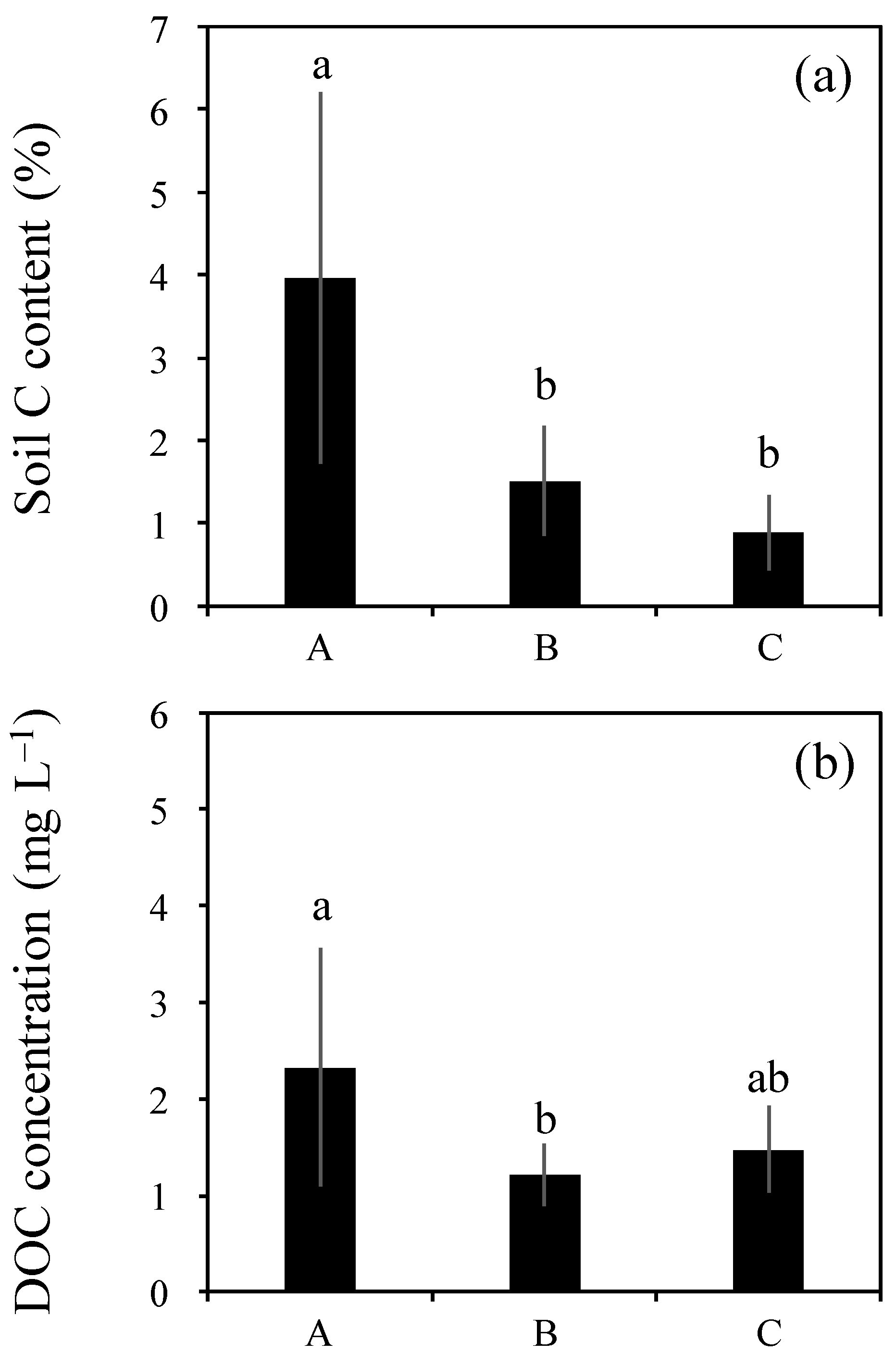
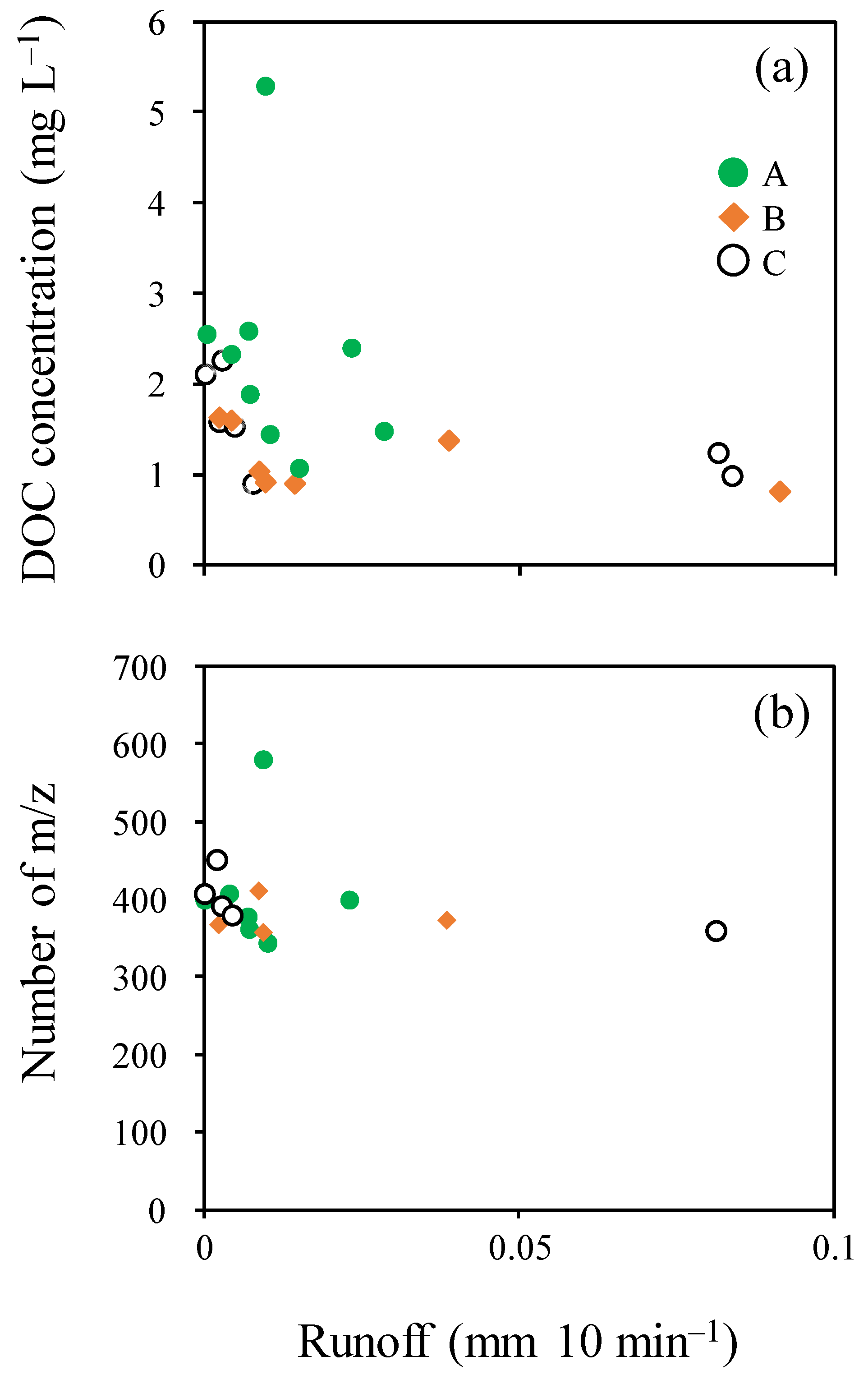
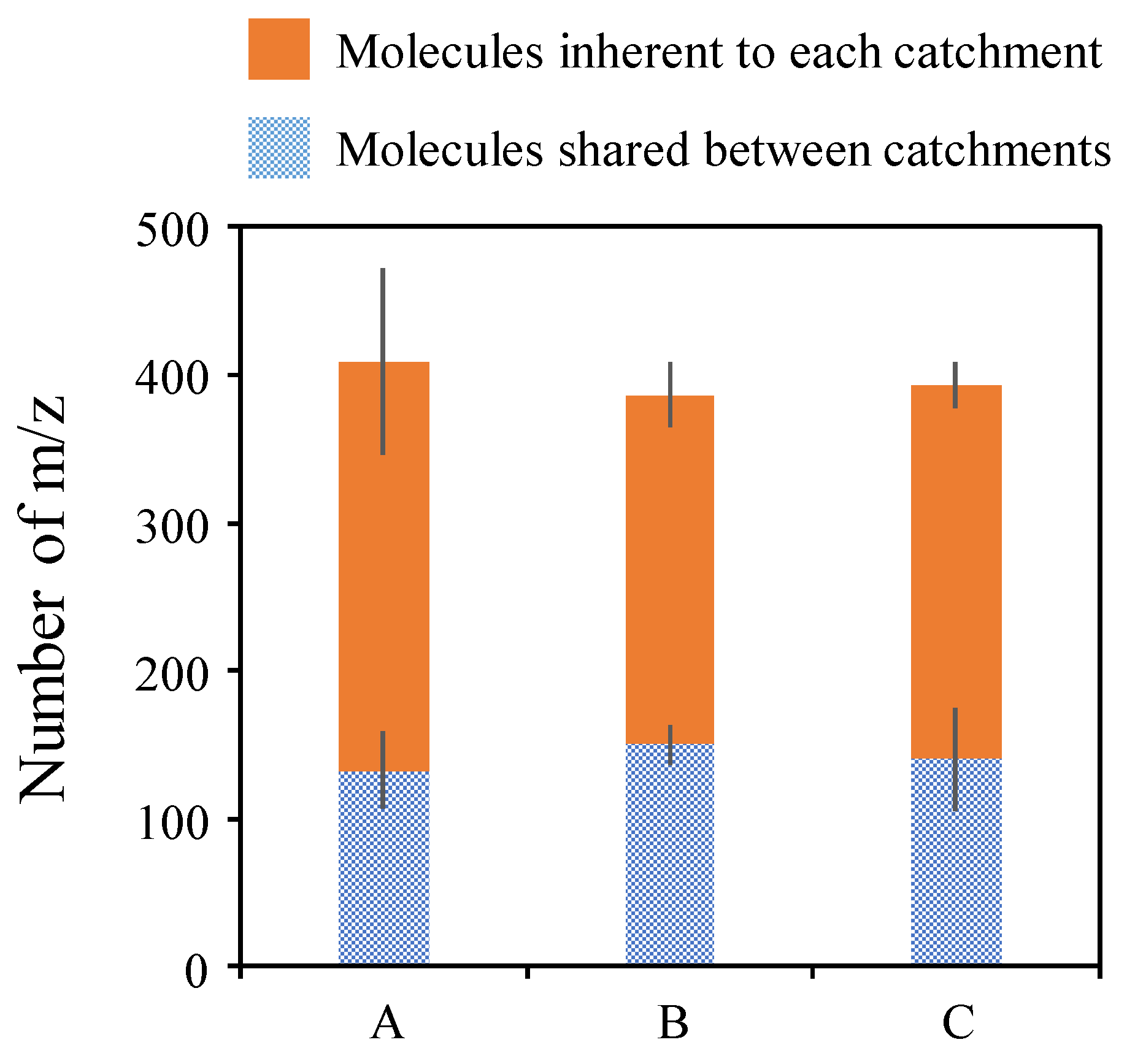
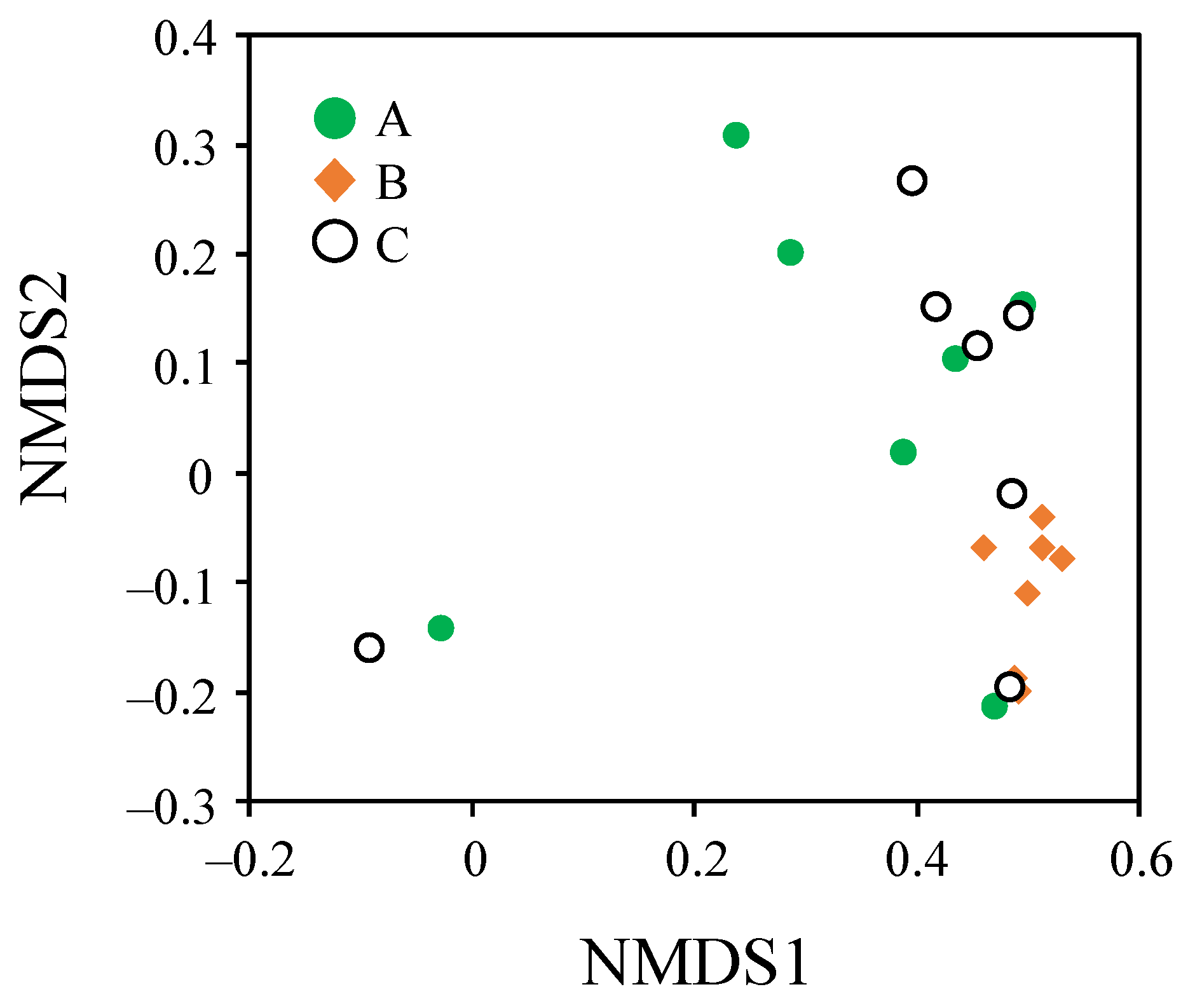
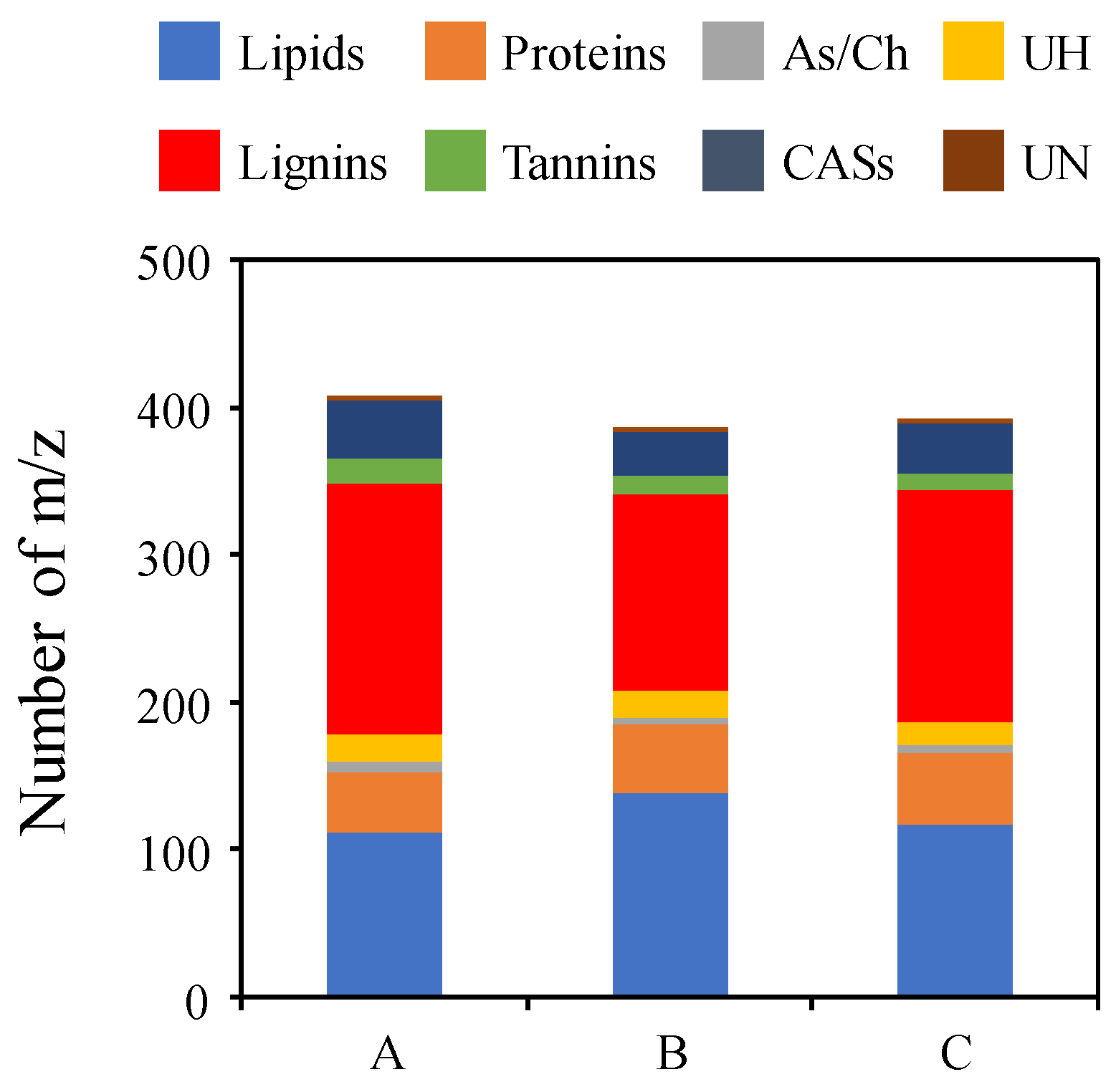
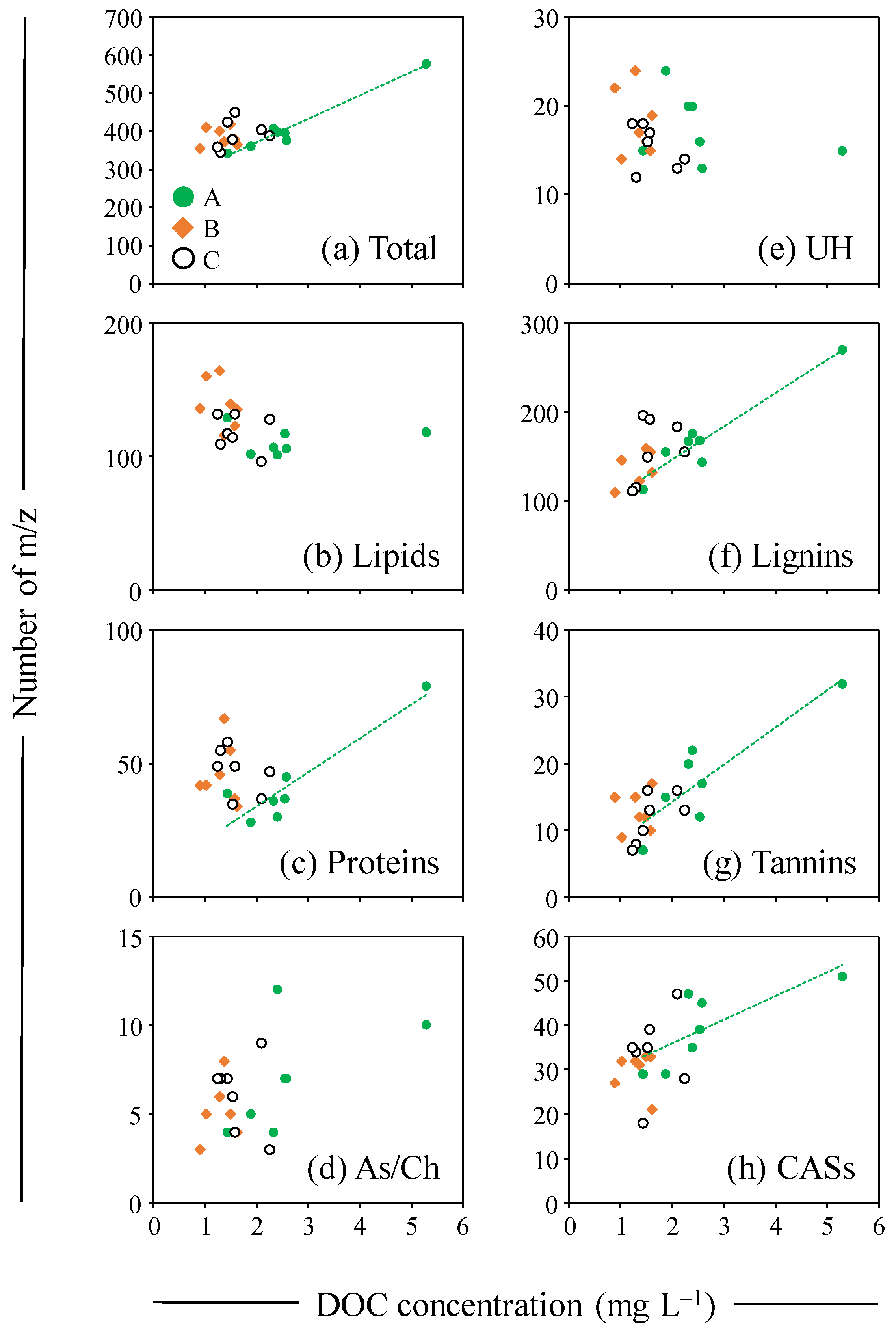
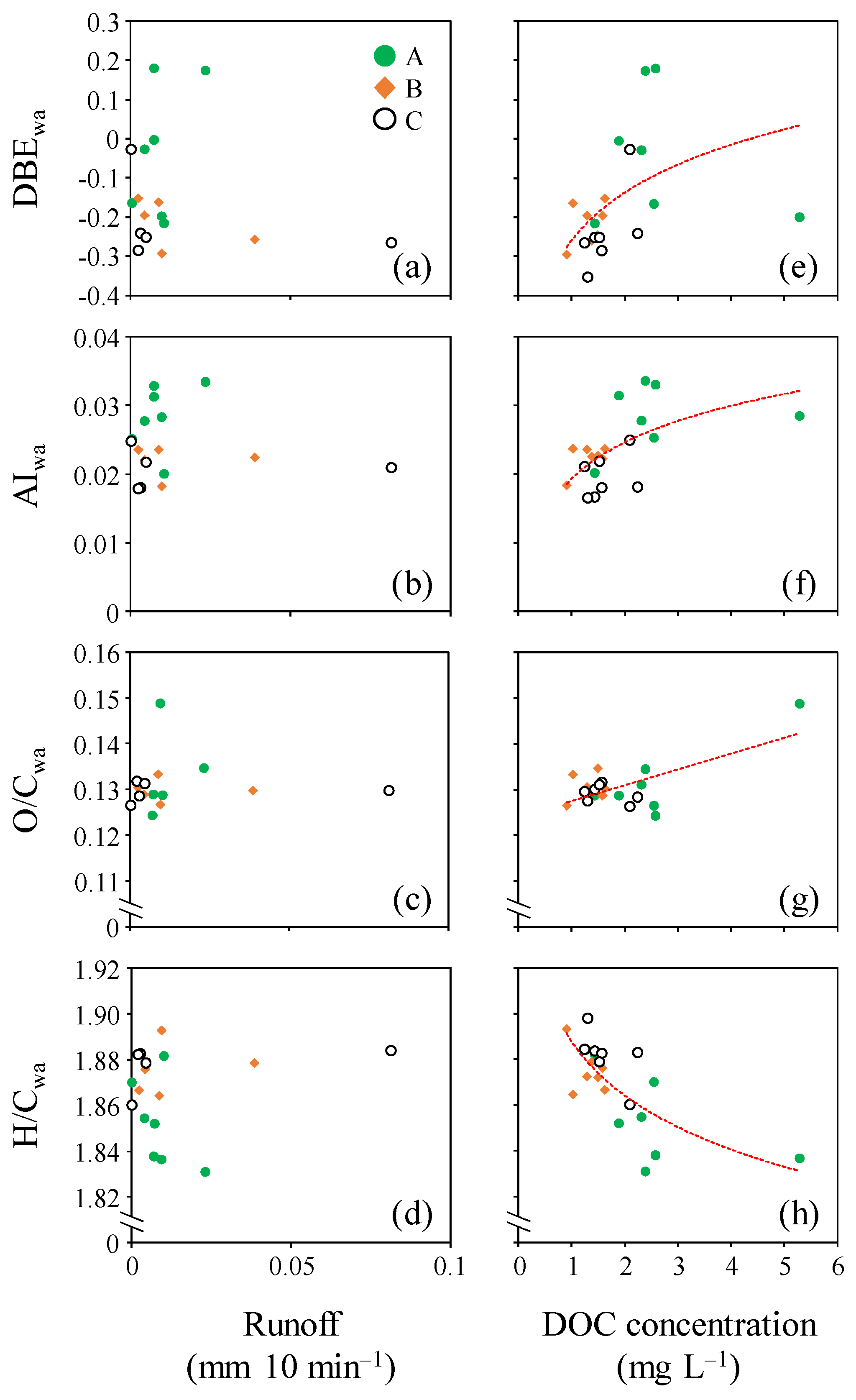
Disclaimer/Publisher’s Note: The statements, opinions and data contained in all publications are solely those of the individual author(s) and contributor(s) and not of MDPI and/or the editor(s). MDPI and/or the editor(s) disclaim responsibility for any injury to people or property resulting from any ideas, methods, instructions or products referred to in the content. |
© 2025 by the authors. Licensee MDPI, Basel, Switzerland. This article is an open access article distributed under the terms and conditions of the Creative Commons Attribution (CC BY) license (https://creativecommons.org/licenses/by/4.0/).
Share and Cite
Ide, J.; Hara, K.; Arata, Y.; Endo, I.; Ohashi, M.; Nishimura, H.; Gomi, T. Molecular Composition of Stream Dissolved Organic Matter in Cool-Temperate Forest Headwaters with Landslides, Northern Japan. Hydrology 2025, 12, 63. https://doi.org/10.3390/hydrology12030063
Ide J, Hara K, Arata Y, Endo I, Ohashi M, Nishimura H, Gomi T. Molecular Composition of Stream Dissolved Organic Matter in Cool-Temperate Forest Headwaters with Landslides, Northern Japan. Hydrology. 2025; 12(3):63. https://doi.org/10.3390/hydrology12030063
Chicago/Turabian StyleIde, Jun’ichiro, Kenta Hara, Yohei Arata, Izuki Endo, Mizue Ohashi, Hiroshi Nishimura, and Takashi Gomi. 2025. "Molecular Composition of Stream Dissolved Organic Matter in Cool-Temperate Forest Headwaters with Landslides, Northern Japan" Hydrology 12, no. 3: 63. https://doi.org/10.3390/hydrology12030063
APA StyleIde, J., Hara, K., Arata, Y., Endo, I., Ohashi, M., Nishimura, H., & Gomi, T. (2025). Molecular Composition of Stream Dissolved Organic Matter in Cool-Temperate Forest Headwaters with Landslides, Northern Japan. Hydrology, 12(3), 63. https://doi.org/10.3390/hydrology12030063





